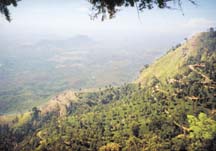
Hair-pin drop to Diyaluma falls
by Florence Wickramage - Daily News Sat Nov 9 2002
|
|
The amazing array of nature's bounties which is the proud heritage of this, our thrice-blessed land offer many prizes and surprises to a discerning traveller who dares to venture forth on an adventurous trail of discovery. From the North to the South, from the East to the West over hills and valleys, amidst boulders and crags, in the gently flowing rivers, streams and cascading waterfalls, on palm fringed golden beaches and the mighty ocean, in the trees and flowers, in animals, birds and butterflies ... there is absolute beauty ...nature's gifts on a platter to the nature lover.
Around 1898, 3 intrepid English and Scottish gentlemen on horseback, roamed the cold and dangerous hills around Haputale located at an elevation of 4900 feet. These three gentlemen Thomas Lipton, George Pilkington and Thomas Villier roamed the thick jungles to hunt Sambhur. Enchanted by the beauty of the hill-country they felt a "whiff of England and Scotland" in the atmosphere and enhanced the beauties of nature by clearing hill-slopes to plant tea. Thus we have been endowed with the velvety tea gardens which produces the world-renowned "cuppa that cheers" (tea). However, to clear the cold jungles which at that time were `infested' with wildlife such as elephants and leopards these Englishmen had to obtain the services of Indian labour for they found that the wet and dry climate in the central region were ideal for tea. They struggled for years to bring the plantations to yield profit.
Lipton's-Seat at Dambatenne Estate, 19 miles from Haputale is the prize left behind by Thomas Lipton and Pilkington Point is the memento of George Pilkington.
|
|
Sir George Pilkington established the Poonagala Estate and established the Pilkington Point in 1898. This place could be reached travelling about 30 km uphill from Haputale through Bandarawela. The path is rugged terrain dangerous at certain points and extremely difficult for vehicular traffic. Since the Pilkington Point overlooks the southern escarpment it commands a rare view of the whole of Southern Ceylon. Clearly visible are Wellawaya, Handapanagala and even the sea - in a circle of 70 km. radius in the mornings. The view is said to be better than the view which the World's End commands.
Dr. C. P. de Silva a nature lover, a traveller and an adventurer himself says that the rough track one has to daringly undertake to reach the Point is amply compensated by the breathtaking beauty and gorgeous splendour of the view that unfolds. " The view cannot be described, but must be seen to be appreciated", he says.
|
|
Sir Thomas Villiers too hitched his wagon to a star and as a planter changed the hills and valleys around him to carpets of tea plantations. He savoured the smell of his creation in the pearly light of the dawn when mists enveloped the plantations, its leaves kissed by dew-drops. Recorded is the fact that "he betook himself to the Bird Sanctuary at Tangamalai in Haputale and standing on a hill-top said to himself "God grant me the serenity to accept the things I cannot change, courage to change the things I can, and the wisdom to know the difference".
Villiers built a granite castle at Glennanore in Haputale and called it "Adisham" after his castle in Kent. To construct the castle he imported Granite from Scotland, Teak and Mahogany from Burma and purchased for himself an English Daimler with a chauffeur. Adisham and the beautiful gardens surrounding it stand today a living memory to this Scotsman who created an Eden on earth. Adisham today is a monastery of the monks of the Order of St. Benedict. (Information and pictures-Courtesy: Dr. C. P. de Silva).